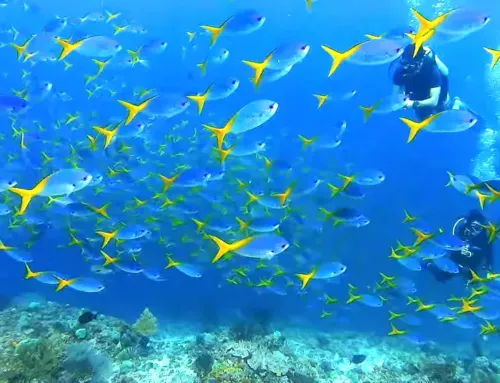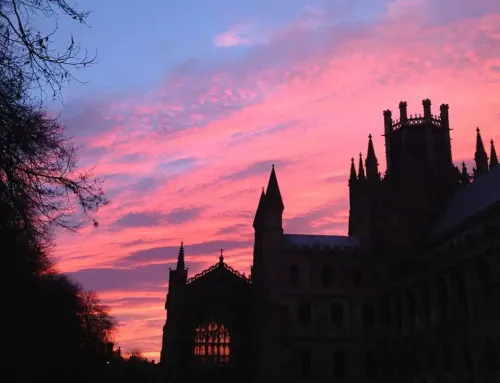The title of this article is a quote from a favorite book of mine by Fr. Thomas Dubay, entitled The Evidential Power of Beauty: Science and Theology Meet (Ignatius Press: 1999). In it he discusses the vast wonder of the created world. He, more than anyone I’ve read, sees the natural world as a sacred window to the divine. I would expect no less from a priest!
“People with lively minds and sparks in their hearts,” he says, “are prone to wonder, to be astonished, and to marvel….They are alive” (129). Here we have, perhaps, the whole thesis of the Christian faith in a nutshell: “Christ came that we might have life and have it to the full” (John 10:10). The life He gave to the world, however, is not simply spiritual redemption. The entire natural world is radiant with His life – for those who have eyes to see.
Father uses all of his 365 pages to propose evidence for this thesis. The superabundant material world provides plenty of it, and although some of his observations are scientific and technical, most of them are the fruit of simple observation and plain common sense, as we will see.
Father spreads his analysis out over three categories of creation: the cosmos, our world and the microscopic world (which he calls macro, midi and micro wonders). Our Divine Prodigality series will reflect this ordering in three separate articles. In using other terms like “the world of nature” and “natural world” etc. I will be specifically referring to the world in which we live for the purposes of this article even though the whole universe is technically the created and natural world.
This first installment addresses the wonders of nature because they are the most observable to the naked eye. Since I don’t have 365 pages to make the case, I’ve summarized below some of the wonderful bits of evidence that Fr. Dubay offers about the beauty of the world around us.
Familiarity is a Drawback
For sheer quantity, quality and quirkiness, the world of nature is a museum of marvels, but it’s easy to overlook the immense beauty because it pervades our daily lives. Fr. Dubay proposes one test question that causes us to think about how easily we take for granted the wonders of the natural world:
What if there were only one lily left in the world?
Undoubtedly, if this were the case, people would be lined up for miles just to see the bloom of this pristine flower and get a whiff of its lovely fragrance.
But if we would long for just a glimpse of such rare beauty in a situation of scarcity, why do we not appreciate it when it is right in front of us? Familiarity tends to breed contempt, they say, or at least boredom. Flora and fauna are so ubiquitous that we rarely take notice of the amazing artistry behind them.
Abundant Life
In my state of Florida, for example, there are palm trees everywhere you look, and they’re all just palm trees, right? Not so fast! Did you know that there are several hundred different species of palm trees in Florida alone and some 3000 species of palm scattered across the globe?
My favorite is the Bottle Palm, which looks like, you guessed it, a bottle: it has a straight, wide trunk that narrows like a bottle’s neck at the top. The smallest palm tree is the Dwarf Palm – rather appropriately named because its smallest version stands just three feet tall. There is also a Pygmy Palm, which towers over the Dwarf at six to eight feet tall.
The tallest palm tree in the world is the 200-foot Wax Palm that inhabits the Andes of central and eastern Colombia. (Some of these have been known to grow up to 300 feet tall.)
Of those species of living things that biologists have been able to classify, there are as many as ten million different types of plants and animals.
Just to list a few in the animal kingdom: there are 59 species of eagles, 200 species of turtles, 8000 species of beetles and more than 3 million distinct species of insects. We could add about ten million more examples, but the point is clear. The world of animals is astoundingly abundant.
Bio-Diversity and Humor
What Fr. Dubay calls the “divine sense of humor” is quite evident in the animal kingdom as well. Armadillos, possums and sloths – as funny as they are in appearance – spend most of their lives just sleeping (80% of every 24-hour period, according to Fr. Dubay). And what are we to make of the giraffe, the hippo, the ostrich, the anteater, the platypus, the hammerhead shark, all those amazingly weird deep sea fish, and, closer to home, the antics of dogs and cats?
If you’re not laughing your head off on a daily basis, you’re probably not paying attention.
Plants? Let’s start with the amazing orchids. There are 35,000 species of them. We can sense something of the Creator’s sense of humor again in the many orchid blooms that actually resemble little animals: wasp, butterfly, flying duck, swans, frogs, even little bearded men!
And don’t overlook the Dancing Lady orchids. The clusters of colorful blooms distinctly resemble groups of tiny ballroom dancers with puffy hoop dresses. My mom actually owned one of these rare gems – you never forget it when you see it. Nor will I ever forget the smell of her Chocolate Orchid, whose fragrance, believe it or not, makes you believe you are walking into a Willie Wonka factory.
As for sheer growth power, nothing equals the watermelon. The tiny black watermelon seed, when planted in the ground, takes in 200,000 times its own weight and volume to produce one full-grown fruit. As to the white rind, green skin and red flesh of the fruit – where do these come from? William Jennings Bryan said, “When you can explain to me the mystery of a watermelon, you can ask me to explain the mystery of God.”
Performance Art
Some animals perform seemingly miraculous feats. They put the greatest human performers and athletes to shame.
A jumbo jet needs a mile of runway to take off and land, but the tiniest bird can hop into the air from a standing position and then land on a twig with elegance and without crashing! (Father Dubay notes: “We never hear of a bird crash,” do we?) It is said that a peregrine falcon can spot its prey from as far as five miles away and, like many species of eagles and hawks, can swoop in at over 200-miles-per-hour for the kill.
Speaking of birds, the hummingbird’s ability to process energy would be impossible to sustain if it were human. An average size man would literally burn up in one hour if he had the kind of energy-burning metabolism of this little bird who could easily fit into the curve of a spoon. The man would also need to eat 285 pounds of food a day just to supply that energy!
Humans are also no match for the feats of strength of earth’s humble creatures. The ant lifts fifty times his weight while the frightening-looking rhinoceros beetle can bear a load of up to 850 times his own weight on his back. These feats are possible because of the intricately-designed insect exoskeletons God gave them. Those of us who have skeletons inside our bodies simply would be crushed.
In jumping ability, the amazing panther can leap about thirty feet from a full run, but it is the common flea who holds the long jump record: he can jump 150 times his own length. For comparison, the Olympic long jump record set by Mike Powell in 1991 (29’ 4¼”) was slightly over four times Powell’s height (6’2”). In matters for which they are specifically equipped, no human accomplishments even remotely compare to these prodigious feats of nature’s beasts.
Our Marvelous World
There is no need to multiply examples. We could go on all day, but we have all this information available to us through the Internet – a human marvel if there ever was one.
What should be clear to those who have eyes to see is that God, the Creator of the universe, is a Prodigal Father. He has woven into His created world such extraordinary tapestries of beauty and wonder that we take them for granted. We overlook them because they are so normal to us. Or, we let stress, technology or obsessive work numb us to the prodigality of beauty all about us.
Only in Christ do we receive the fullness of God’s life, but these natural phenomena are expressions of His life, tiny foretastes of the life that awaits us in heaven.
Composer Michael Kurek has said, “If only we could see God’s immanence in everything He has created … what a wonderfully sacred world we might perceive and inhabit.”
I say amen to that.
Soul Work
Years ago a retreat master said that whenever something strikes us out of the blue as fascinating, unusual or beautiful we should always stop what we are doing and wonder for a few moments. If something makes an impression on our souls there is probably a good reason for it; that impression alone merits our closer attention. Developing a habit of looking under the surface of things is a way to build one’s strength of soul.
Today – without fail – something will strike you as beautiful, fascinating or extraordinary. Wonders are all around us. It may be a phenomenon of nature (like a full moon), a sincere human gesture or wonderfully expressed talent. Perhaps it’s just an ordinary physical object whose mystery opens up to you in a flash of inspiration.
Stop and contemplate. Those few minutes will transform your day and maybe even your strengthen your soul.
—-
Source: Fr. Thomas Dubay, The Evidential Power of Beauty: Science and Theology Meet (San Francisco: Ignatius Press, 1999), 149-164.




Lovely article, only the use of the word “Prodigal” with our Father is a great trouble as the word means wasteful of one’s own resources rashly using them, unable to use them properly so as to being oneself into poverty.
I do expect that the author meant otherwise.
God bless, C-Marie
Thanks Marie. I made a note of that in Part 2 and clarified it, but I should also have done that here. Prodigal can mean lavish in generosity but sometimes the turn of phrase is not clear when the generally understood meaning is negative. I’ll see what I can do to correct this article too. thanks for the feedback. Peace.